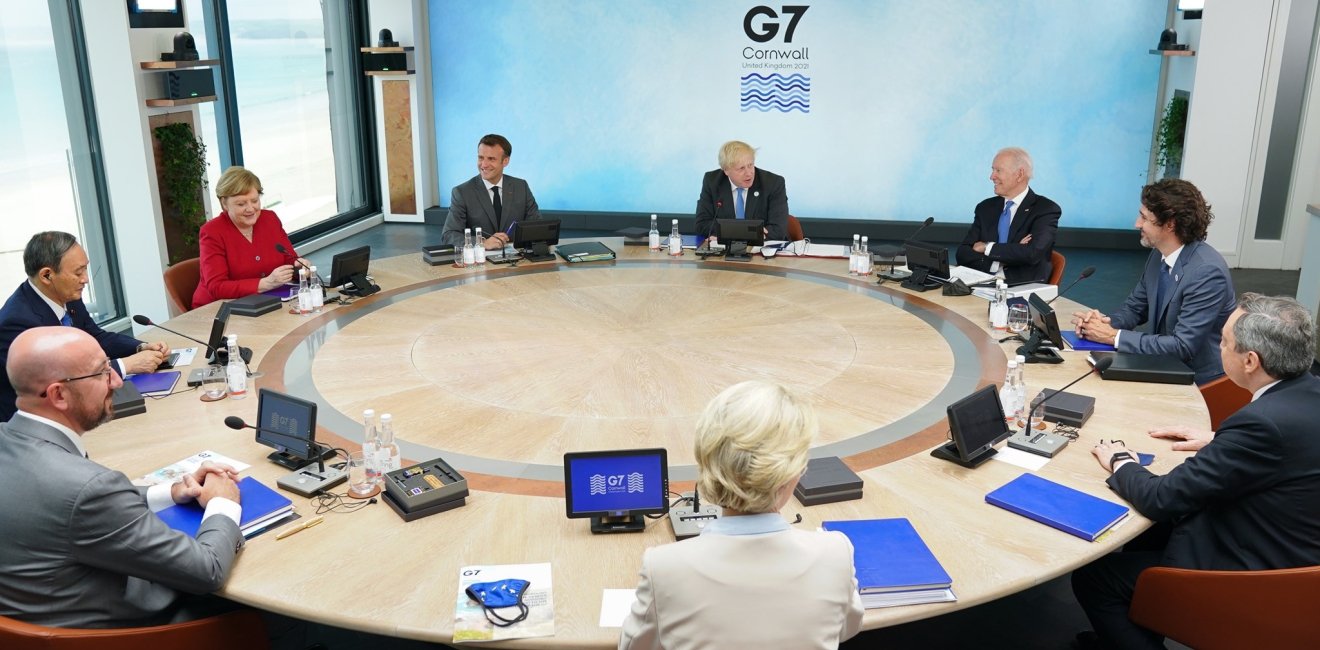
A blog of the Indo-Pacific Program
The communique released to conclude the latest G7 summit meeting in the UK was eerily familiar. As the statement called for unity among the world’s wealthiest nations to work together to ensure steady recovery after the global pandemic, and to strengthen democracies worldwide, it echoed much of the prerogatives that had been highlighted in the U.S.-Japan joint statement following the meeting of President Biden and Prime Minister Suga in Washington the previous month. Most notable was singling out the threats posed by China, including Beijing’s disregard for established economic rules, the violation of human rights, and territorial claims in the South as well as East China Seas. With Australia, South Korea, and India invited as observers, the G7 made clear that it spoke with one voice in expressing its concerns about Chinese challenges to the status quo across Asia and beyond. The message was clear: there was a global consensus about Chinese aggressions, and that the world’s most powerful countries were united in their objection, with Washington leading the way. Or certainly, that has been the narrative that the White House has been pressing in marking Biden’s first overseas visit as president. But what has also become apparent is that not only is China too endeavoring to build up its own coalition of countries, the G7’s united front against China may not easily translate into an actionable roadmap.
It is no coincidence, though, that China too hosted an ASEAN foreign ministers’ meeting in Chongqing the same week the G7 summit took place. What’s more, the agenda at the Beijing-led gathering also focused on post-COVID recovery assistance which remains of foremost concern to all countries in the region as they continue to grapple with the continued spread as well as access to preventive vaccines. China’s push to promote its domestically produced vaccine and financial assistance plans to address immediate social needs complement its broader Belt and Road Initiative geared for longer-term infrastructure development. Although Washington continues to assert that Beijing remains without allies and partners, unlike the United States, China clearly has not only come up with a strategy, but also the financial commitment, to court many key countries in Southeast Asia.
For its part, the United States demonstrated at the first in-person G7 and NATO summit meetings that it is committed not only to work together with like-minded countries, but it is also able to steer the agenda to address some of Washington’s biggest concerns.
For its part, the United States demonstrated at the first in-person G7 and NATO summit meetings that it is committed not only to work together with like-minded countries, but it is also able to steer the agenda to address some of Washington’s biggest concerns. Certainly, key issues addressed in the U.S.-Japan bilateral statement in May is reflected in the G7 statement, most notably in framing competition with China in a global context and rallying for coordinated support in pushing back against Beijing’s disregard for economic, diplomatic, and security norms that threaten stability in the Indo-Pacific and beyond. The fact that South Korea, Australia, and India were invited as observers to the G7 further demonstrated the unity of U.S. allies in Asia, while NATO’s focused discussions on China highlighted how Beijing’s actions are now also pose a grave threat to the military alliance that had hitherto focused on European security and the risks from Russia.
Although both France and Germany have already outlined their respective Indo-Pacific strategies, Europe’s concerns about the risks China poses to the continent’s security have only increased. Beijing’s initiatives that have created friction between Eastern and Western European countries by offering lucrative economic incentives to the former have led the EU to reassess the real cost of acquiring Chinese capital.
Yet Europe is far more hesitant than Japan to align too closely with the United States in pushing back against China. Although France has overseas territories in the Indo-Pacific and regards itself as a Pacific power, the EU at large remains geographically distanced from China and the security challenges facing the region. While Japan’s ultimate aim may be to preserve the status quo and continue to decouple its close economic ties with China on the one hand and regard Beijing as its single biggest military threat on the other, the prospects of being able to continue hedging is becoming increasingly challenging. Europe, on the other hand, still remains more focused on maintaining stability in the region and securing economic opportunities with Beijing.
Coupled with the fact that the G7 has yet to develop a specific plan backed with solid financial support as to back up its rhetoric to provide an alternative development assistance roadmap to BRI, the unity on addressing the China challenge will have reached its peak. With Beijing taking concrete steps including financial support to meet the immediate needs of Asia struggling to recover from the pandemic in addition to BRI, the world’s richest nations must compliment their commitment to democratic governance with an effective development assistance strategy with financial backing in order to meet the needs of the emerging markets of Southeast Asia.
Follow Shihoko Goto, deputy director for geoeconomics and senior associate for Northeast Asia, on Twitter @GotoEastAsia.
The views expressed are the author's alone, and do not represent the views of the U.S. Government or the Wilson Center. Copyright 2020, Asia Program. All rights reserved.
Author


Indo-Pacific Program
The Indo-Pacific Program promotes policy debate and intellectual discussions on US interests in the Asia-Pacific as well as political, economic, security, and social issues relating to the world’s most populous and economically dynamic region. Read more





